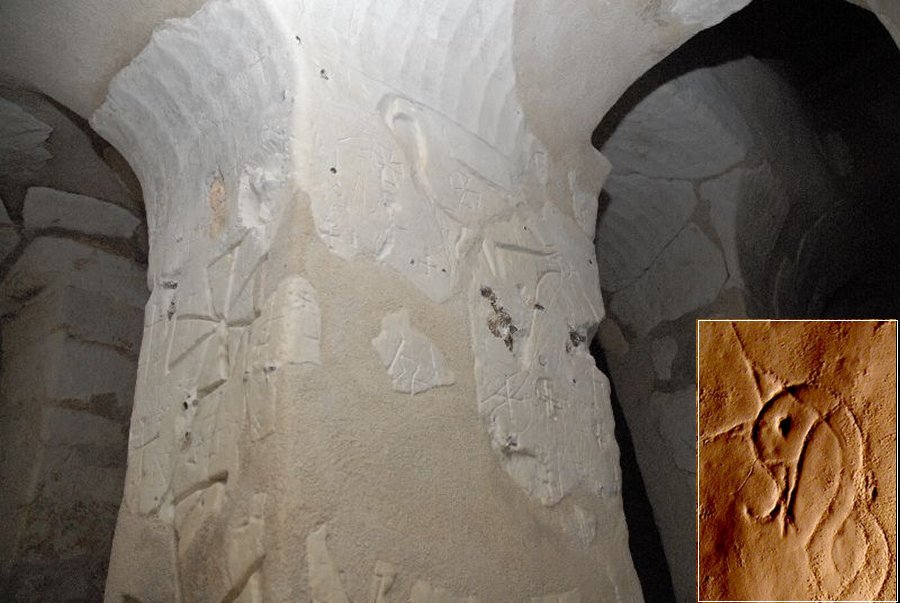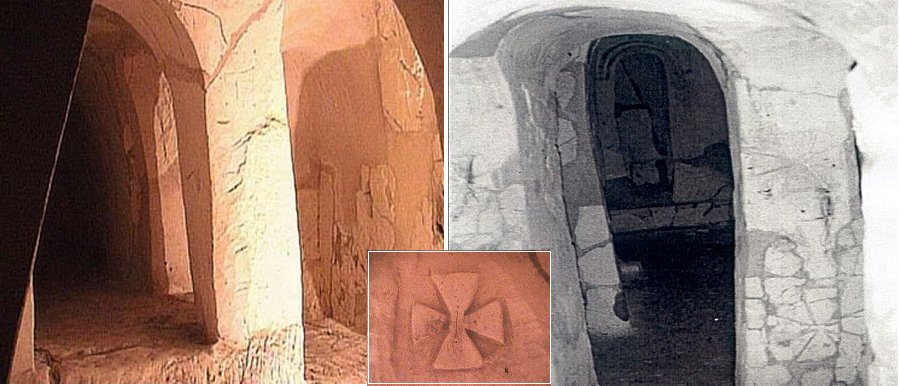Ancient Cave Church Complex In Basarabi, Romania
A. Sutherland - AncientPages.com - In 1957, a complex of caves, crypts,. six chapels, and tombs dated to 9-10th century, was found near Murfatlar, a port on the Danube-Black Sea Canal, Constanta County, Romania.
Ancient cave monastery in Basarabi was dug into the chalky limestone hill at several, different levels, into the vertical walls of the ancient quarry. Between 1924–1965 and 1980–2007, the town Murfatlar (in Turkish, "generous man") was known as Basarabi and this name is still used in respect to ancient cave complex.
Most of the chamber-walls are covered with overlapping graffiti, including drawings and multilingual inscriptions carved on the walls in Old Slavic, some in Greek alphabet and some in Turkic runes and some in Romanian. There are also runic signs, which still remain a scientific mystery.
The Basarabi culture concentrated in Southeastern Europe, mainly in Romania and dated between 8th - 7th centuries BC. It was named after Basarabi, a village in Dolj County, south-western Romania, today, an administrative part of the Calafat municipality.
This culture is related to the Hallstatt culture of the Iron Age period, the Hallstatt A (12-11th BC) and B (10-8th BC) corresponds to the late Bronze Age, Hallstatt C (7th BC) to the early Iron Age, and Hallstatt D (6th BC) to the Iron Age.
Like in some cultures of the region, the human settlements of the Basarabi culture, were usually open but sometimes also fortified, however, dwellings differed considerably within one culture.
They ranged from pit-dwellings and small huts to two-roomed rectangular houses, between 6 to 8 meters long and 3-4 meters wide.
Platforms which were frequently used in the Neolithic period, were not excavated, however, the living are of these people was equipped with a stamped clay floor.
In "Encyclopedia of Ancient Greece", Nigel Wilson writes: “the territory of modern-day Romania has been populated from the Palaeolithic period, but the country’s historical period begins in the 9th-8th centuries BC and is connected in southwestern Europe with the so-called Thracian Hallstatt period (c.600-550 BC), which corresponds to European Hallstatt C. Basarabi culture is considered the most representative of this new period within Romanian territory. The population was formed of mainly agricultural tribes living in fortified or open villages whose dwellings were constructed of timber….”
The caves of the Basarabi Church complex were discovered richly decorated with numerous drawings on the walls, depicting animals and men, riders, birds, and Christian symbols.
A large series of drawings is represented by mythical figures of monsters and dragons, along with halberds and an image of a Viking ship depicted on the walls, are all in favor of a northern origin.
During the years 1957-1962, an important monastic complex Basarabi, was discovered, near a big chalk quarry.
See also:
Mysterious Cucuteni-Trypillian Culture Burned Their Settlements For Unknown Reasons
Mysterious Underground Labyrinth With Secret Passages In Dobrogea
Spectacular Vardzia Cave Monastery – Huge Underground Complex Founded By The “Mountain Queen” Tamar
Researchers have linked these discoveries to the trade route between Scandinavian areas and Constantinople, known under the name “the route from the Varegs (= Vikings) to the Greek”.
However, they still have difficulty trying to decipher runic texts in Basarabi, due to their fragmentary preservation and the absence of many elements. It is not even known if they were written from left to right or from right to left.
For the time being, the runic writings remain undeciphered.
Written by – A. Sutherland - AncientPages.com Senior Staff Writer
Copyright © AncientPages.com All rights reserved. This material may not be published, broadcast, rewritten or redistributed in whole or part without the express written permission of AncientPages.com
Expand for referencesReferences:
Cambridge Ancient History (second addition, volume III)
More From Ancient Pages
-
 Don’t Underestimate The Rishis – Ancient Sages Were ‘Probably Great Scientists’
News | Sep 26, 2015
Don’t Underestimate The Rishis – Ancient Sages Were ‘Probably Great Scientists’
News | Sep 26, 2015 -
 Strange Radiation Case – Medical Files Secretly Erased?
Featured Stories | Sep 13, 2019
Strange Radiation Case – Medical Files Secretly Erased?
Featured Stories | Sep 13, 2019 -
 God Odin Was Exiled From Asgard – The Kingdom Of The Gods – But He Had No Regrets For Breaking Norse Society’s Norms
Featured Stories | Feb 10, 2018
God Odin Was Exiled From Asgard – The Kingdom Of The Gods – But He Had No Regrets For Breaking Norse Society’s Norms
Featured Stories | Feb 10, 2018 -
 Magnificent Viking Treasure Accidently Found In Norway – Was It Hidden Or Sacrificed?
Archaeology | Nov 3, 2022
Magnificent Viking Treasure Accidently Found In Norway – Was It Hidden Or Sacrificed?
Archaeology | Nov 3, 2022 -
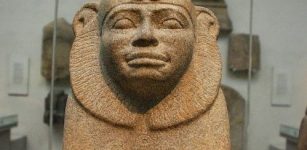 Taharqa – The Most Powerful Of The Black Pharaohs
Featured Stories | Jan 29, 2016
Taharqa – The Most Powerful Of The Black Pharaohs
Featured Stories | Jan 29, 2016 -
 Can Aikman Mounds In Arkansas Explain The Hopewell Culture’s Mysterious Disappearance?
Featured Stories | Apr 30, 2019
Can Aikman Mounds In Arkansas Explain The Hopewell Culture’s Mysterious Disappearance?
Featured Stories | Apr 30, 2019 -
 Discovery Sheds Light On Why Pacific Islands Were Colonized
Archaeology | Apr 22, 2022
Discovery Sheds Light On Why Pacific Islands Were Colonized
Archaeology | Apr 22, 2022 -
 Mysterious Bones May Re-Write History Of North America – Humans Were Present On The Continent 10 Times Earlier
Archaeology | May 8, 2017
Mysterious Bones May Re-Write History Of North America – Humans Were Present On The Continent 10 Times Earlier
Archaeology | May 8, 2017 -
 Bizarre Ancient Lie Detector – The Mouth Of Truth – Bocca della Verità
Artifacts | Dec 12, 2015
Bizarre Ancient Lie Detector – The Mouth Of Truth – Bocca della Verità
Artifacts | Dec 12, 2015 -
 Researchers Confirm Museum Shrunken Head As Human Remains
Archaeology | Aug 4, 2022
Researchers Confirm Museum Shrunken Head As Human Remains
Archaeology | Aug 4, 2022 -
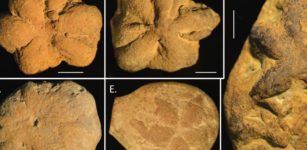 Mysterious Ancient Star-Shaped ‘Fossil’ Baffles Scientists – What Is It?
Archaeology | Feb 27, 2023
Mysterious Ancient Star-Shaped ‘Fossil’ Baffles Scientists – What Is It?
Archaeology | Feb 27, 2023 -
 Did The 8 Omens Of The Aztecs Foretell The End Of Their Civilization?
Civilizations | Jan 30, 2020
Did The 8 Omens Of The Aztecs Foretell The End Of Their Civilization?
Civilizations | Jan 30, 2020 -
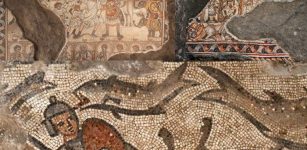 World’s Oldest Mosaics Of Biblical Jonah And The Whale Discovered
Archaeology | Jul 23, 2017
World’s Oldest Mosaics Of Biblical Jonah And The Whale Discovered
Archaeology | Jul 23, 2017 -
 A Ptolemaic Mummy Reveals Evidence Of Dental Filling Used In Ancient Egypt
Archaeology | Aug 6, 2020
A Ptolemaic Mummy Reveals Evidence Of Dental Filling Used In Ancient Egypt
Archaeology | Aug 6, 2020 -
 On This Day In History: Johannes Kepler ‘Father Of Modern Astronomy’ Was Born – On Dec 27, 1571
News | Dec 27, 2016
On This Day In History: Johannes Kepler ‘Father Of Modern Astronomy’ Was Born – On Dec 27, 1571
News | Dec 27, 2016 -
 Excavations Of 7th Century Shipwreck In Israel Reveal Christian And Muslim Symbols
Archaeology | Aug 1, 2020
Excavations Of 7th Century Shipwreck In Israel Reveal Christian And Muslim Symbols
Archaeology | Aug 1, 2020 -
 Kantyua And Tantyua – Sacred Tibetan Books Reveal Incredible Lifespan Of The Gods
Artifacts | Mar 18, 2019
Kantyua And Tantyua – Sacred Tibetan Books Reveal Incredible Lifespan Of The Gods
Artifacts | Mar 18, 2019 -
 Mysterious Tiny Pre-Viking Gold Foil Figures Baffle Scientists
Archaeology | Nov 5, 2019
Mysterious Tiny Pre-Viking Gold Foil Figures Baffle Scientists
Archaeology | Nov 5, 2019 -
 2,000-Year-Old Fountain In Kibyra, The City Of Gladiators Flows Again
Archaeology | Jan 3, 2023
2,000-Year-Old Fountain In Kibyra, The City Of Gladiators Flows Again
Archaeology | Jan 3, 2023 -
 The Ancient Giants Who Ruled America: The Missing Skeletons And The Great Smithsonian Cover-Up
Biblical Mysteries | Apr 26, 2014
The Ancient Giants Who Ruled America: The Missing Skeletons And The Great Smithsonian Cover-Up
Biblical Mysteries | Apr 26, 2014


